Neighborhood safety/watch groups
Forming or joining a Neighborhood safety/watch group can help reduce the likelihood of burglary AND increase overall safety on your block.
There are countless other benefits of starting a NW group including social events and disaster preparedness. Above all, a NW group increases your connectedness to your neighbors.
To kickstart a neighborhood safety/watch on your block:
Start by applying for a city-sponsored neighborhood safety/watch group by applying via SF SAFE via the link below or clicking here: Request Services. SF SAFE is a city-run non-profit safety organization who facilitates city-sponsored neighborhood watch groups and have decades of experience. They can tell you if a group already exists on your block. Unfortunately, it currently takes several months to get a response. SF SAFE will coach you through the below steps in a formal process, but you needn’t wait for them to get started. SF SAFE’s guide to starting is available here and contains lots of useful information and ideas you can utilize. If your block chooses to complete SF SAFE’s formal training program requirements, your block will receive a Neighborhood Watch sign.
Next, start by talking to neighbors to see if a group already exists.
Blocks are typically all homes and buildings that face a shared street.
Identify a block leader (or two) who is willing to organize and be the central point of contact for the group, preferably someone with basic online organizational skills (to share info quickly and efficiently). Consider bilingual leaders who can more easily reach non-English speaking neighbors.
Leader(s) should begin by alerting neighbors of their plans to start a neighborhood watch group via emails, flyers, and in-person word-of-mouth. Indicate that you are forming a group, including contact info and instructions on how to join.
Next, leader(s) should gather neighbor’s contact information (with permission) and build a sharable contact list using a Google doc, sheet, group or other online platform. Note: it’s likely that not all neighbors will participate. That’s ok. If neighbors resist or have concerns, just move on. Start small and grow.
Info you may want to organize includes:
Names of residents, address, phone #, email address
ID neighbors who may have special needs (Seniors, disabilities, medical, language barriers, etc.)
ID neighbors with particular practical skills (Nurse, CPR, carpentry, plumber, generator, language translation, etc.)
Cars: make, model and tag # (to avoid towing or ticketing neighbors)
Pets
Out-of-State emergency contacts
A block map
Which neighbors have security cameras or video doorbells
Try to make your group’s neighbors’ information sharable and easily accessible to everyone in the group, but private and inaccessible to anyone not in the group.
Consider planning an online video or in—person meeting to get acquainted and discuss ways that neighbors can support and look out for one another. A good kickstarter is to capture and document everyone’s expectations and desires for your block’s group.
For more tips and ideas, watch the below video featuring experienced neighbors who have successfully started neighborhood safety/watch groups in the Richmond District.
Don’t Wait. Get Started TODAY.
A recent meeting of neighbors sharing tips from those who have successfully started Neighborhood Safety/Watch Groups in the Richmond District…..
You can view and download SF SAFE’s guide to starting a Neighborhood watch here.
